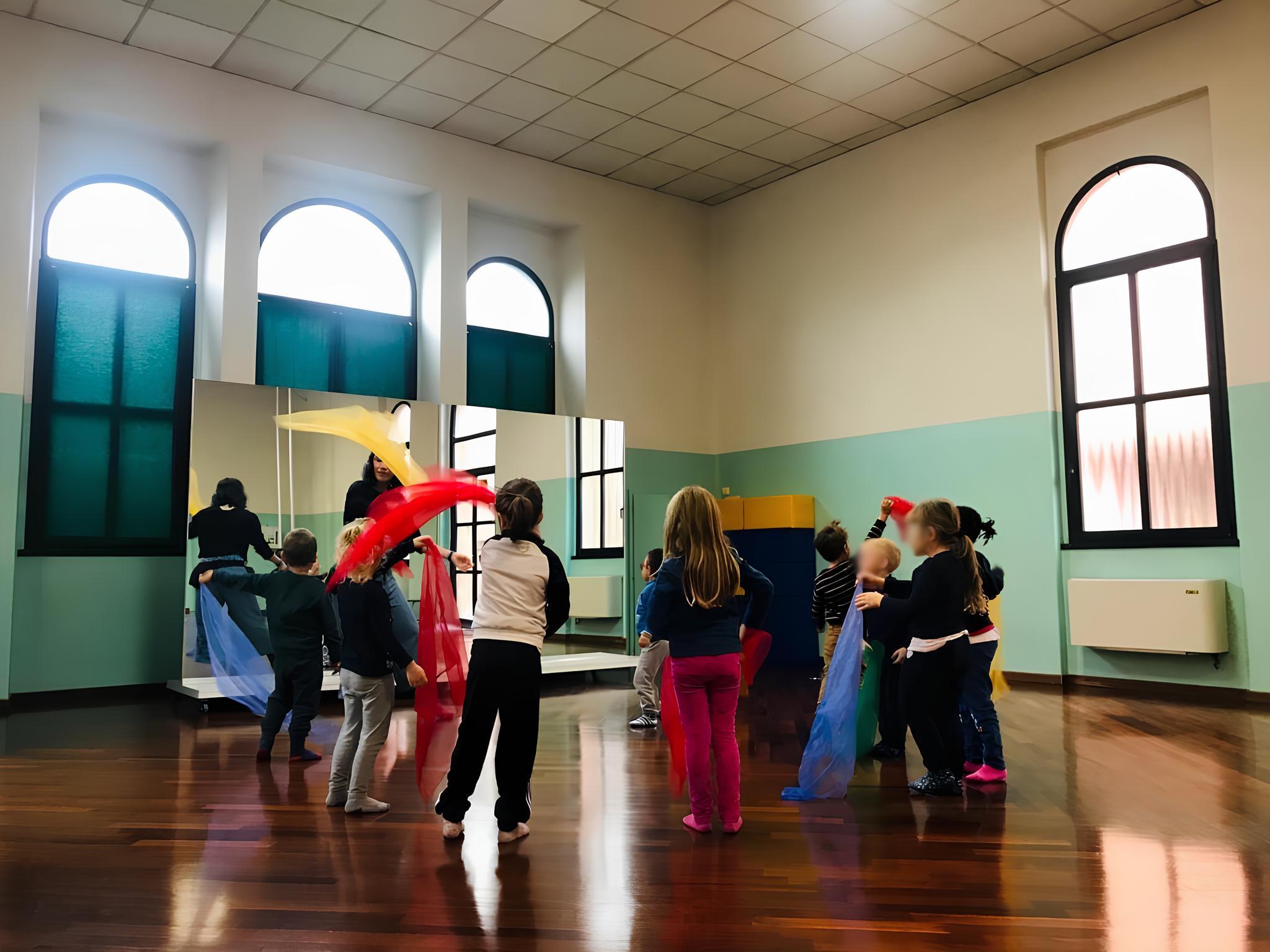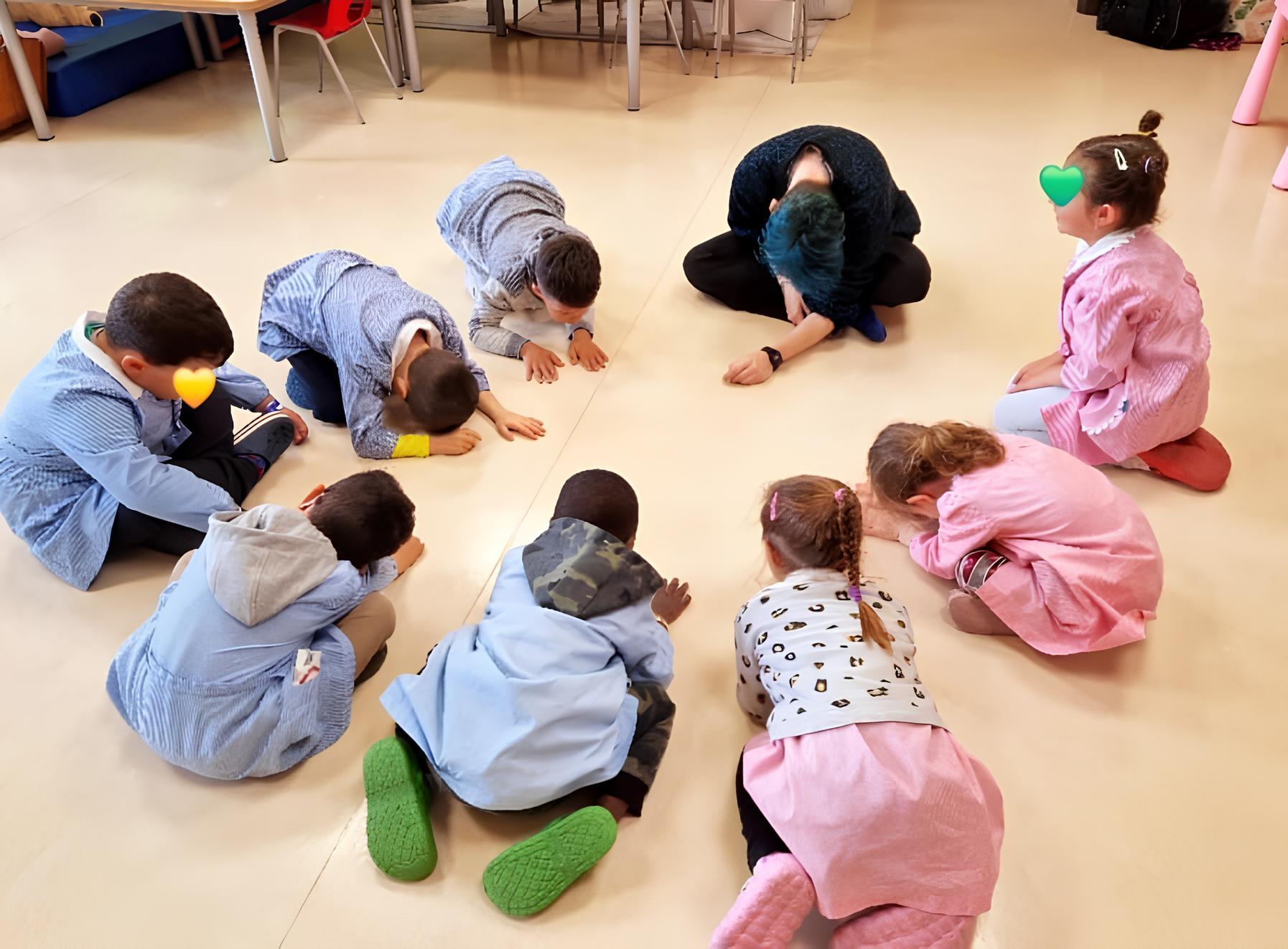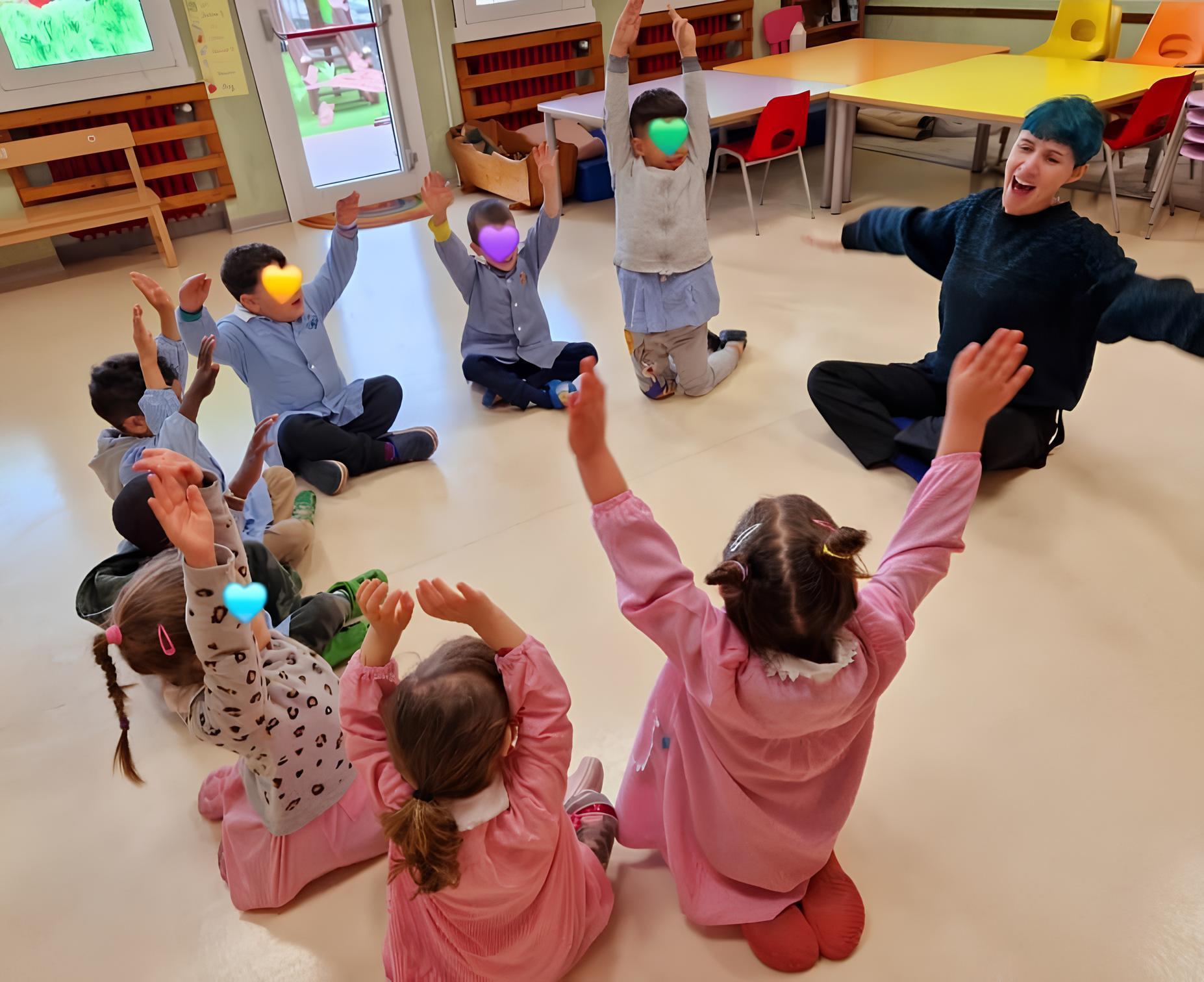Music Learning Theory (MLT), formulated by Edwin E. Gordon in the 1960s, is the foundation of the “Gordon method.” MLT educational practice guides preschool children to acquire and internalize music as a communication code through intuitive, informal, and playful approaches. The music educator’s informal guidance draws from how children naturally learn their mother tongue. This approach replicates key facilitating elements: immersion in a musical environment, interactive dialogue, and repeated exposure.
Through activities centered on voice, wordless singing, movement, and musical dialogue, we nurture pitch accuracy, rhythmic sense, and a rich musical vocabulary. This vocabulary includes improvisation, songs, and specific musical phrases that children can access freely in their vocal explorations, much like they use words when creating spontaneous speech.

Preschoolers in a music class by Nicol Bana.
The cross-cultural value of vocal exploration
The sound of the human voice as a carrier of ultra-semantic, musical, and interactive meanings is the “event” upon which the lesson is based. Verbal language is suspended throughout. This wordless voice is sung and modulated with neutral syllables such as “pa” or “ba,” in a musical syntax in which all elements (e.g., harmonic, rhythmic, etc.) are “signifiers” with which to play and communicate. Their meaning is not fixed and codified. In a group of children, the meaning of musical signifiers is relational and emotional. Through non-directive teaching, the MLT educator offers songs, activities, and patterns (short musical phrases). This framework allows the child to experiment vocally in a group of peers with continuity and guidance.
The environment itself facilitates the creation of this exploratory space and helps the child take advantage of it. Guidance from a musically competent adult model provides direction and brings the exploration into a musical and collective context, pointing out possible directions and ensuring that the conditions are in place for the child to experiment with them. The features of this approach enable me to observe the daily processes of vocal sound production as a means of communication and play in groups of children. This enables me to appreciate the cross-cultural value of vocal exploration.
Vocal invention, storytelling, and identity
In the age group of 0–2 years, I hear a variety of spontaneous vocal qualities, including a creaky voice that seems to undergo progressive selection after age two. Whether or not children have been exposed to vocal qualities at school or at home plays a large role in this process. In the preschool years (2–6 years), selection is promoted by the creation of stereotyped voices. Children discover that their voice matters and has an identity.
At this age, external references increasingly come to the fore: To express emotions, fantasy characters are brought to life, animated by stories told by adults and by media of all kinds. These vocal personalities have their own, often caricatured, fantasy, and they are, in most cases, the only experience children have with their ability to produce many different vocal qualities. That is why it is important to expose them to other voices, stimulate their imaginations, spark their curiosity, and help them find a sound for what they know but cannot communicate.
With 3–6 years old children, I work primarily with wordless musical “stories” that I express through different vocal qualities and vocal sounds, without suggesting a particular “reading.” They are free to respond to this musical communication by imitating, varying, or inventing new phrases of mine. The perception of the different modes of my voice is usually quite unanimous. For example, a piercing “head” voice is generally recognized as a fairy witch; a soft and caricatured “chest” voice may be perceived as a clumsy bear or gentle giant. Growling is perceived as animalistic or monstrous.
Creaking, on the other hand, evokes different reactions: Some children perceive it as animalistic—similar to growling—others as creaking wood, still others as a silly voice. Matilde (age 2), for example, has developed a “creature” that she personifies by making high-pitched creaking sounds and moving like a funny animal. She can easily switch from this creature to a neutral voice while following, modifying, or developing musical patterns with different voices. She did not start singing in class until she discovered that it was “allowed” to play with her voice in this way.
The anecdote makes me think about the implications of perceiving the creak as another voice in symbolic games and role-playing. As described earlier, creaking is less obvious for children to understand than other vocal sounds, probably because it is less common in everyday life. Therefore, such “otherness” can give voice to new narratives and create an unprecedented and raw expressive environment. Yet such creative space is strongly defined by external, stereotypical, and gendered references (e.g., the Disney princess). I wonder if imagination can take over fantasy within the fuzzy boundaries of other voices and open up a space where gendered narratives do not define creative action and elaboration.
When the characteristics of a sound are not defined, as is the case with creaky-voice-gendered identities who appear less standardized and more malleable. In my experience, children can use this approach to overcome the divisions of “blue” or “pink.”

Music class (note the gendered dress code).
Case studies in vocal exploration
An example of this is the case of Selena (age 5). When I first met her, her singing and movement qualities were evidently influenced by stereotypical female princess characters. Her interest in music seemed to be focused solely on imitating this kind of character. The growling made her laugh but seemed too masculine (as she told me) and did not match her “standards.” The creaking sound, on the other hand, surprised her; I saw how much fun she was having finding a way to play with it, even physically (she is primarily a dancer). In subsequent sessions, she discovered ways to stop limiting herself to a fictional character. Toward the end of the school year, she proposed melodies of her own invention and qualities of movement that had never been seen before, which were very personal and not at all stereotypical.
Normally, growling seems to evoke a gendered perception that is biased toward the masculine, while creaking seems to be much less, if at all, gendered. This speaks to the great potential of other voices to promote inclusion and equity in the educational context. One classroom circumstance that supports this view occurs frequently with (so-called) “antagonistic” behaviors in the 3–6 age group. Inclusive exploration of voice is a helpful resource for connecting with others.
Keeping in mind that there is no pedagogical formula that will solve classroom management and teacher–student relationships once and for all, vocal exploration can be a powerful resource. Once children discover that their other voices, whether loud, bellowing, grotesque, monstrous, or bizarre, can be used to make music and play together, it facilitates the expression of their need to express themselves individually and fit in with the group.
Irene (age 4), for example, spent several encounters between selective silence and the desire to leave. Suddenly, one day, completely out of context (we greeted each other sitting in a circle on the floor), she began croaking and jumping around like a frog. I responded by doing the same, and the rest of the group joined in the game. The play was then tied back into the musical context of the lesson, and a new version of the song emerged, enriched here and there by frog-like croaking.

Kindergarten music class.
Using “all voices”
From then on, albeit with ups and downs, I saw Irene begin to interact with the group and participate in activities and vocal dialogs until the end of the class. Another example is Giovanni (2½ years old), who was calmly participating in class for half a school year when suddenly he started saying “No!” to everything. One day he spoke to me quite angrily, in a Louis Armstrong-like growly voice. I picked up that tone and improvised with him, accompanying it with the guitar. An interesting dialog emerged, gradually evolving from the growl to Giovanni’s voice, without being reminiscent of Armstrong. It was confirmed as a complicit play. In the following sessions, I was able to find a way to welcome him back into the group.
In addition, the inclusion of extreme—that is, extremely unexplored—voices proved to be a valuable resource in solving classroom problems. The vocal exploration of channeled extremes was an opportunity to build relational bridges with children who seemed inaccessible. Continuity is the key differentiator in building such an educational relationship. It is critical to create a safe and defined space to channel children’s emerging needs and encourage their curiosity without putting them at a disadvantage. This requires the careful use of a welcoming attitude.
When free vocalization is not seen as mere exploration for its own sake, but is guided and structured to make music together, an enriching power emerges from diversity. It leads to connections between children despite and because of diversity. When the class community builds a relationship that legitimizes the use of “tutte le voci” (all voices), creative teaching is received with greater enthusiasm.
The author of this expression is Erik, a 5½-year-old boy. As we talked at the end of a preschool class, he said in amazement at the new discovery, “So we can make music with all voices.” I have adopted this expression in all classes since. Among these sounds, the creaky voice holds a special place. It is not associated with a particular character; it can take on different forms and connotations—stimulating language games that encourage imagination rather than fantasy. Creak, however, is only one of the many other voices available to us in the educational context. They are powerful allies in setting the stage to know one’s own voice. This encounter is of great creative and human value.